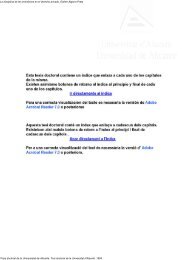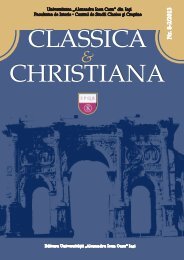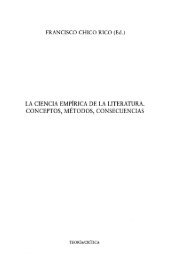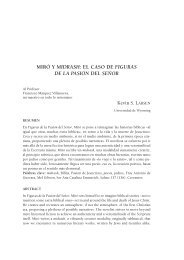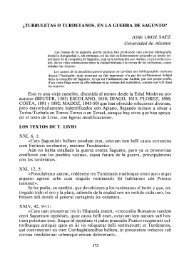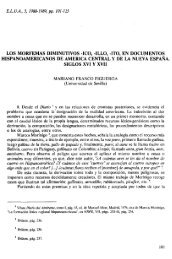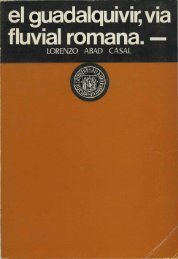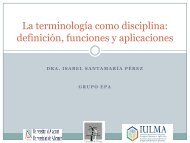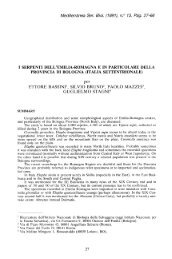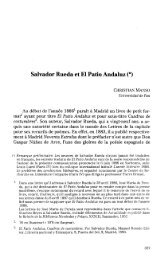goethean rhymes and rhythms in verse translations of faust ... - RUA
goethean rhymes and rhythms in verse translations of faust ... - RUA
goethean rhymes and rhythms in verse translations of faust ... - RUA
Create successful ePaper yourself
Turn your PDF publications into a flip-book with our unique Google optimized e-Paper software.
2trans<br />
Beyer, Stefan<br />
Accord<strong>in</strong>g to the Catalan physician <strong>and</strong> theosopher José Roviralta Borrell (1920:7), whose prose<br />
translation is reputed to be the most faithful one to this day, translat<strong>in</strong>g Goethe's Faust is a task<br />
“worthy <strong>of</strong> titans”. For future translators, especially those attempt<strong>in</strong>g to create a Spanish Faust<br />
<strong>in</strong> <strong>verse</strong>, it is therefore helpful to study the exist<strong>in</strong>g versions, as they provide a guidel<strong>in</strong>e as to<br />
which approaches may be adopted <strong>and</strong> which are best avoided. This study is part <strong>of</strong> my attempts<br />
to help prepare new <strong>and</strong> improved <strong>verse</strong> <strong>translations</strong> <strong>of</strong> Goethe's Faust <strong>in</strong>to Spanish.<br />
Over the past one hundred <strong>and</strong> fifty years, a large number <strong>of</strong> <strong>translations</strong> <strong>in</strong>to Spanish <strong>of</strong><br />
Goethe's magnum opus have been published. Initially, they <strong>of</strong>ten reflected certa<strong>in</strong> cultural<br />
misunderst<strong>and</strong><strong>in</strong>gs <strong>and</strong> stereotypes, for example, the Faust character <strong>in</strong> those early versions <strong>in</strong><br />
Spanish <strong>of</strong>ten appears to be an unscrupulous seducer, whose sole aim it is to obta<strong>in</strong> love <strong>and</strong><br />
knowledge by means <strong>of</strong> magic. The author <strong>of</strong> this seem<strong>in</strong>g German Don Juan, “the most<br />
questionable” <strong>of</strong> our classics accord<strong>in</strong>g to José Ortega y Gasset (1932: 46), appeared to be<br />
equally <strong>in</strong>human until well <strong>in</strong>to the 20 th century. Even a learned homme de lettres like Rafael<br />
Cans<strong>in</strong>os Assens (1957: 1: 252) arrives at the disturb<strong>in</strong>g conclusion about Goethe that<br />
he sacrificed everyth<strong>in</strong>g for his proper ego: loves, friends, everyth<strong>in</strong>g. He was a good adm<strong>in</strong>istrator<br />
both <strong>of</strong> his wealth <strong>and</strong> his adrenal<strong>in</strong>e. His triumphant path is scattered with bloodless victims. His<br />
law is the law <strong>of</strong> the strongest; those who cannot resist him have to die.<br />
The cultural misunderst<strong>and</strong><strong>in</strong>gs <strong>in</strong>volved <strong>in</strong> the reception Goethe met with <strong>in</strong> Spa<strong>in</strong> <strong>in</strong> the 19th<br />
<strong>and</strong> early 20 th centuries were thoroughly studied by Udo Rukser (1958) <strong>and</strong> Robert Pageard<br />
(1958).<br />
The history <strong>of</strong> the <strong>verse</strong> <strong>translations</strong> <strong>in</strong>to Spanish <strong>of</strong> Goethe's Faust is even more surpris<strong>in</strong>g,<br />
due to the fact that the secrets <strong>of</strong> Goethe's versification are not easily revealed. In general, the<br />
pr<strong>in</strong>ciples <strong>of</strong> <strong>verse</strong> composition <strong>in</strong> Spanish <strong>and</strong> German go by different st<strong>and</strong>ards. In Hispanic<br />
meters, the ma<strong>in</strong> criterion is the number <strong>of</strong> syllables per <strong>verse</strong>, whereas the distribution <strong>of</strong><br />
stressed syllables can be used to vary the rhythm <strong>of</strong> this ever same number <strong>of</strong> syllables, e.g. an<br />
endecasílabo can have a trochaic or a dactylic rhythm, but they are not always expected to form<br />
regular patterns. In the century <strong>in</strong> which Goethe was born, German metrics had come to focus<br />
less on the overall number <strong>of</strong> syllables per <strong>verse</strong> <strong>and</strong> more on the number <strong>of</strong> stressed syllables,<br />
thus imitat<strong>in</strong>g the rules <strong>of</strong> versification common <strong>in</strong> antiquity. Consequently, the rules for writ<strong>in</strong>g<br />
pentameters are not quite the same as for endecasílabos.<br />
Among the twenty-six meters employed <strong>in</strong> the first part <strong>of</strong> Faust, the most characteristic one<br />
is the Knittelvers, a type <strong>of</strong> pentameter rhymed <strong>in</strong> couplets with certa<strong>in</strong> irregularities, which<br />
became famous through the carnival plays <strong>of</strong> Hans Sachs <strong>in</strong> the 16 th century. Two centuries later,<br />
Goethe employed the then ill-reputed Knittel <strong>verse</strong> <strong>in</strong> a provocative manner creat<strong>in</strong>g a<br />
somewhat comic, doggerel-type effect (cf. Ciupke 1994: 38). However, more than half the 4612<br />
<strong>verse</strong>s <strong>of</strong> Faust I are written <strong>in</strong> Madrigalvers, a meter rhymed either <strong>in</strong> couplets, alternately or<br />
enclos<strong>in</strong>g, <strong>in</strong> which <strong>verse</strong>s <strong>of</strong> four, five or six iambic feet are alternated. Goethe also used the<br />
Stanzenstrophe (ottava rima) for his Faust, a stanza consist<strong>in</strong>g <strong>of</strong> eight iambic pentameters<br />
rhym<strong>in</strong>g abababcc. The <strong>rhythms</strong> <strong>of</strong> Goethe's poem are so varied that not even the most<br />
elaborate prose could do them justice, e.g. the melodic chant <strong>of</strong> the archangels or the dreamy<br />
stammer <strong>of</strong> the protagonist when he expla<strong>in</strong>s his creed to his <strong>in</strong>genuous lover Margaret.<br />
The other crucial aspect <strong>of</strong> the unmistakable metrical form <strong>of</strong> Faust are its <strong>rhymes</strong>. How are<br />
translators to approach passages <strong>in</strong> which rhyme is turned <strong>in</strong>to the topic <strong>of</strong> conversation <strong>of</strong><br />
rhymed dialogue, e.g. when it is claimed <strong>in</strong> “Walpurgis Night's Dream” that the German noun<br />
MonTI 5trans (2013). ISSN 1889-4178



